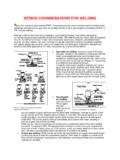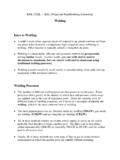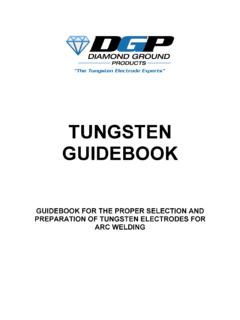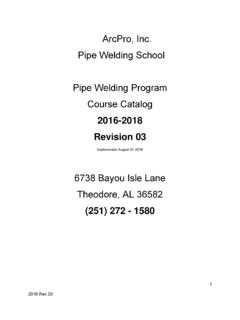Transcription of The Fundamentals Of Orbital Welding - pro …
1 Orbital Welding first found usein the 1960 s when the aero-space industry recognized theneed for a superior joiningtechnique for aircrafthydrolic lines. The solution: a mechanism torotate a Welding arc from a tungsten elec-trode around a tube-weld joint. Regulatingweld current with a control system auto-mated the entire process. The result was amore precise, reliable method than Welding became practical formany industries in the early 1980 s with thedevelopment of portable combinationpower supply/control systems that operatedfrom 110-V AC. Modern Orbital weldingsystems offer computer controls that storewelding schedules in memory. The skills ofa certified welder are thus built into thesystem, enabling the production of enor-mous numbers of identical welds andleaving little room for error or Orbital Welding in many precision orhigh purity applications, the basematerial, tube diameter(s), weldjoint and part fit-up require-ments, shielding-gas type andpurity, arc length, and tungsten -electrode type, tip geometry, andsurface condition may alreadybe written into a specificationcovering the specific applica-tion.
2 In addition, Orbital -weldingequipment suppliers can offerrecommendations on equipmentsetup and use. For those applications whereno specificaton exists, the engineer respon-sible for Welding must create the weldingsetup and develop the Welding Welding uses the gas- tungsten -arc- Welding (G TAW) process as the source ofthe electric arc that melts the base materialand forms the weld. During G TAWan electricarc forms between a tungsten electrode andthe workpiece. To initiate the arc, an RF orhigh-voltage signal will ionize the shieldinggas to generate a path for the weld capacitor dumps current into the arc toreduce arc voltage to a point where thepower supply can regulate. The powersupply responds to the demand and providescurrent to maintain the weldabilityIn general, the commonly used 300-seriesstainless steels offer a high degree of weld-Material weldability, joint design, FundamentalsOf Orbital WeldingBernard MannionModern Orbital - Welding systems offer computer controlsthat store Welding schedules in memory.
3 The skills of a certifiedwelder are thus built into the system, enabling the production ofenormous numbers of identical welds and leaving little room forerror or defects. This article serves as a guide for creating thewelding setup and developing Welding Mannion is sales and marketingmanager of Pro-Fusion Technologies Inc.,Newbury Park, Calif., manufacturers of pre-ground tungsten electrodes for Orbital andtube-mill applications For more informa-tion, call (805) 376-8021; fax (805) 376-0619; e-mail visit the firm s website, series of enclosed Orbital -weld heads, like the one seenhere, join tubing 1/16 to 6inches in diameter with wallthickness to inch. Forwelding larger-diameter andthicker-wall tube, fabricatorsopt for open style using Orbital equipment except forTypes 303/303SE, which contain additivesfor ease of machining.
4 The 400-series stain-less steels, while generally weldable, mayrequire post-weld heat should be prepared to adjustthe Orbital - Welding setup to accommodatefor potential differences among materialheats. The chemical composition of eachheat will vary in the concentration ofalloying and trace elements, which canaffect conductivity and melting characteris-tics. Minor deviations in elements such assulfur can affect fluid flow in the weld pool,completely changing the weld profile, whilealso potentially causing arc wander. Whenwelding on a material from a new heatnumber, the fabricator should weld a testcoupon for the new heat he may need tomake minor changes in amperage togenerate the required weld fitupFitup is dependent on the weld-specifica-tion requirements on tube straightness, weldconcavity, reinforcement, and drop no specifications exists, the laws ofphysics require that the molten materialflow and compensate for tube mismatch andany gap in the weld in tube diameter or out-of-roundness will cause weld-joint mismatchand arc-gap variations from one weldingsetup to use of tube and pipe end-prepfacingequipment helps to ensure end squarenessand flatness.
5 The and should beburr-free with no two tubes butt together forwelding: Ensure that no gap exists greater than 5percent of the wall thickness. While theequipment can handle gaps of 10 percent ofwall thickness, or greater in some instances,weld quality and repeatability will suffer. Check that the wall thickness and tubealignment varies in the weld zone by nomore than plus or minus 5 percent ofnominal. Again, the laws of physics willallow Welding with mismatch of up to 25percent of wall thickness, but, again, weldquality and repeatability will alignment mismatch by using engi-neering stands and clamps to align the twotubes to be welded. This setup also avoidsrequiring the weld head to force the tubesinto basicsDufing Welding , an inert gas directed tothe tube and prevents the moltenmaterial from combining with oxygen in theambient atmosphere.
6 With sufficientshielding-gas coverage, welds can have zerotint at the weld zone is the most commonly usedshielding gas, for the and as the gas. Helium is often used for weldingon copper alloys; mixed gases such as 98Ar-2 H2, 95 Ar-5H2, 90Ar-10 H2, or 75 He-25 Ar find use on heavy wall tube, inchand thicker. Using 95 Ar-5 H2can causehydrogen embrittlement in welds on carbonsteels and some exotic alloys. As a generalrule, for simplicity and to minimizeshielding-gas costs, use 100 percent gas purity is dictated by theapplication. For high-purity tasks such aswelding of tubing used in semiconductorand pharmaceutical applications, where theconcern for micro-contamination is para-mount, engineers specify a ultra-high-puritygas or a gas with a local purifier to minimizeor eliminate the heat tint.
7 For non criticalapplications, commercial-grade and Applicationsfor Orbital Welding Aerospace:The aerospace industrywas the first to recognize the advantagesof automated Orbital Welding . The high-pressure systems of a single aircraft cancontain more than 1,500 welded joints,all automatically created with orbitalequipment. Boiler tube:Boiler-tube installation andrepair offer perfect applications for orbitalwelding. Compact Orbital weld heads canbe clamped in place between rows ofheat-exchanger tubing. Food, dairy and beverage industries:These industries require consistent full-penetration welds on all weld jonts. Formaximum piping-system efficiency, thetubing and tube welds must be assmooth as possible. Any pit, crevice,crack, or incomplete weld joint can trapthe fluid flowing inside the tubing,becoming a harbor for bacteria.
8 Nuclear piping:The nuclear industry,with its severe operating environmentand associated specifications for high-quality welds, has long been an advocateof Orbital Welding . Offshore applications:Sub-seahydraulic lines use materials whoseproperties can be altered during thethermal changes that accompany atypical weld cycle. Hydraulic jointswelded with Orbital equipment offer supe-rior corrosion resistance and mechanicalproperties. Pharmaceutical industry:Pharm-aceutical process lines and pipingsystems deliver high-quality water totheir processes. This requires high-quality welds to ensure a source of waterfrom the tubes uncontaminated bybacteria, rust, or other Welding ensures full-penetrationwelds with no overheating that couldundermine the corrosion resistance ofthe final weld zone. Semiconductor industry:The semi-conductor industry requires pipingsystems with exteremely smooth internalsurface finish to prevent contaminantbuildup on the tubing wall or weld large enough, a build-up of particu-late, moisture, or contaminant couldrelease and ruin the batch process.
9 Tube/pipe fittings, valves, and regu-lators:Hydraulic lines, liquid- and gas-delivery systems, and medical systemsall require tubing with termination systems provide a means toensure high productivity of Welding andoptimum weld typical Orbital tube weld. Note theoverlapping, pulsed-arc finish to theweld : The right toolfor the jobThe tungsten electrode, the source of thewelding arc, is singularly the most impor-tant element of the Welding system. Whileno one would refute the importance of theignition device on an automobile airbag, therip cord for a parachute, or quality tires forour automobiles, the importance of thetungsten electrode is often in manual or automatic Welding ,this is one area where metal fabricators canimprove the consistency of their weldingoutput with minor effort.
10 By selecting theproper tungsten -electrode type and style, theengineer balances the benefits of a clean arcstart and reduced arc wander with goodweld penetration and satisfactory Materials:For a long time, tungsten manufacturers have added anoxide to pure tungsten to improve the arc-starting characteristics and the longevity ofpure tungsten electrodes. For orbitalwelding, the most commonly used electrodematerials are 2-percent thoriated tungstenand 2-percent ceriated :Many users of the G TAWprocess donot realize that thorium is a radioactiveelement grinding of thoriated- tungsten elec-trodes generates a radioactive dust. Cerium,as a base material, has lower work functionthan thorium, thus it offers superior emissioncharacteristics, improving arc-starting abilitywithout the threat of Tip Geometry:As more andmore companies look for ways to optimizeweld quality, process consistency andrepeatability become paramount.






